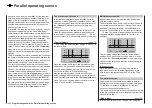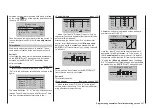
286 Programming examples - Winged models
entiation can be set:
This serves to eliminate the negative torque. The
downward deflected aileron normally generates a
higher level of resistance during the flight than when
deflected upward the same distance, whereby the
model is pulled to the “wrong” side. In order to prevent
this, with the input of a differentiation of the travel of
the respective servo deflected downward is reduced
accordingly. A value between 20 and 40 %, in this
case, seldom arises, however, the “correct” setting
must be sought.
The option “AI
RU” (aileron
rudder) also serves
a similar purpose, as well as for the comfortable con-
trol of a model. A value of about 50 % is a practical
initial value. However, this function should be made
switchable with the assignment of a switch if you
ever have aerobatic flight ambitions. (The author, for
example, switches off this mixer “automatically” when
switching to the “Speed” flight phase, in which he as-
signs both options to the same switch accordingly.)
The last option in the »Wing mixers« menu, the
“El
Fl” mixer, is not yet of interest at the moment.
If the model-specific settings were made thus far, the
initial start can be considered. If course, at first you
should perform a “dry run”, meaning you should care-
fully check all the settings once again on the ground.
Incorrect programming can damage more than just
the model! In case of doubt, ask the advice of an
experienced model pilot.
If you should find during the testing that one or mul-
tiple settings must be made for the adjustment of
the rudder effects to your control habits, the control
throws are too long or short on the whole, you should
adjust this in the …
»Dual Rate / Expo«
… to your own requirements and habits.
“Dual Rate” establishes a relationship between stick
travel and control travel, see page 130:
100%
100%
100%
Ail
Ele
Rud
DUAL
–––
–––
–––
SEL
On the other hand, if the maximum throws are OK
and only the reactions around the center position are
to strong for more sensitive controls, then the “expo-
nential” functions comes (additionally) into play:
0%
0%
0%
EXPO
–––
–––
–––
SEL
Ail
Ele
Rud
If a switch is also assigned, switching can even take
place between two dual-rate/expo settings during the
flight.
This is similar for the option …
»Channel 1 curve«
Input
Output
Point ?
0%
0%
0%
Ch1 curve
Curve off
With this option, one or multiple points of the control
curve of the throttle/brake stick can be influenced in
such a way that a pleasant or even purposeful behav-
ior is guaranteed.
An example of this would be the “dead” travel of spoil-
ers. The flaps first pass through this after a certain
“idle travel” of the brake stick from the wing. With a
corresponding “bending” of the curve, the “dead’ travel
is covered more quickly. The spoilers come out from
the wing earlier and then the remaining travel can be
controlled with greater sensitivity. (This also applies
for the control of a motor in the same manner, which
can be controlled through C1 as an alternative.)
Finally, the receiver’s behavior in the event of a failure
should certainly be established in the menu…
»Fail safe«
Fail-safe adjust
Pos
hold
1 2 3 4 5 6
DELAY : 0.25s
STO
… because “doing nothing” is the worst thing which
can be done for a winged model.
In the transmitter’s home position, “Hold” is speci-
fied and “Hold” means that the receiver continuously
sends the last correctly recognized control impulse to
the servos in the model. In the best case scenario the
model flies straight ahead for an indefinite amount of
time and then hopefully “lands” somewhere without
causing significant damage! However, if something
like this happens in the wrong place at the wrong
time, the model may become uncontrollable and “tear”
across the flight field completely out of control, putting
Summary of Contents for HoTT MC-16 Series
Page 1: ...Programming Manual mc 16 mc 20 HoTT 1 en mc 16 mc 20...
Page 27: ...27 For your notes...
Page 53: ...53 For your notes...
Page 61: ...61 For your notes...
Page 65: ...65 For your notes...
Page 71: ...71 For your notes...
Page 103: ...103 For your notes...
Page 107: ...107 For your notes...
Page 111: ...111 For your notes...
Page 155: ...155 For your notes...
Page 165: ...165 For your notes...
Page 201: ...201 For your notes...
Page 229: ...229 For your notes...
Page 231: ...231 For your notes...
Page 261: ...261 For your notes...
Page 265: ...265 For your notes...
Page 301: ...301 For your notes...
Page 327: ...327 For your notes...
Page 328: ...328 For your notes...
















































